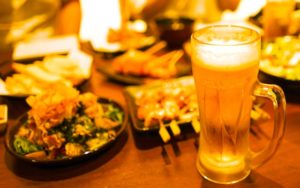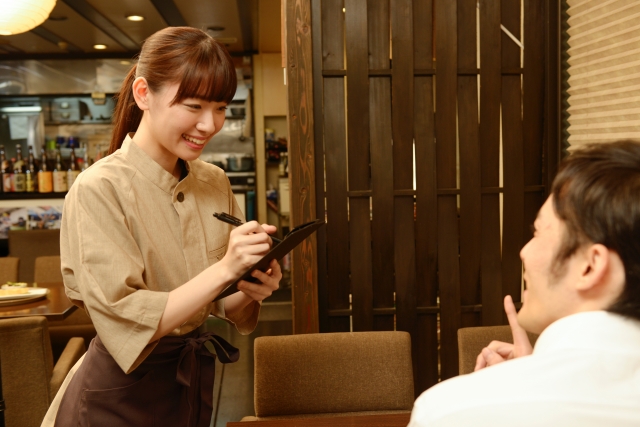Guide to Order Food in Japanese at Restaurants
Many tourists have difficult times when communicating with staffs while traveling Japan, especially at restaurants. So, it will be helpful to learn how to order food in Japanese to make your dining experience smooth and fun.
Most restaurants follow the same format; entering a restaurant, ordering a drink, ordering food, and paying. You don’t have to be worried about being asked unexpected personal questions like “where have you visited in Japan so far?.” The phrases shown below can be used at any types of restaurants.
We will introduce how to order food in Japanese with common phrases and commonly asked questions by waiters/waitresses. Also, we will tell you additional useful phrases you can use when you come across unexpected situations. At the bottom, we listed the name of items that you often encounter at restaurants. So be sure to read to the last!
Let’s get started!
Entering the restaurant

When you enter the restaurant, staffs welcome you by saying “いらっしゃいませ”(Irasshai mase; welcome), and the conversation follows.
Staff: ”何名様ですか?”(Nanmei sama desuka?; How many people?)
You; ”ふたりです。”(Futari desu.; Two.)
If you are single, you can say “ひとりです。”(Hitori desu.)
Staff; ”ご案内いたします。”(Goannai itasimasu.; This way, please.)
Sometimes the staff asks you if you smoke.
Staff; ”おタバコは吸われますか?”(Otabako wa suwaremasuka?; Do you smoke?)
You; ”はい/いいえ。”(Yes/No.)
Or,
Staff; ”禁煙席と喫煙席どちらになさいますか?”
(Kinenseki to Kitsuenseki dochirani nasai masuka?; Do you prefer smoking seats or non-smoking seats? )
You; ”禁煙席/喫煙席で。”(Kinenseki/Kitsuenseki de.; I would like smoking seats/non-smoking seats.)
After seated
Staff; “こちら、メニューでございます。”(Kochira, menyu de gozaimasu.; Here is the manu.)
You; “ありがとうございます。”(Arigatou gozaimasu.; Thank you.)
Sometimes English is written along with Japanese, but if it is written only in Japanese, you can ask the waiter/waitress for the English menu by saying “英語のメニューはありますか?”(Eigo no menyu wa arimasuka?; Do you have an English menu?). Most restaurants, especially chain restaurants offer menus in an English version.
Ordering a drink

It is unusual to order drinks before ordering food at normal restaurants, but if you go to Izakaya (restaurants for drinking), you order your drink first.
Staff; ”お飲み物は何になさいますか?”
(Onomimono wa nani ni nasaimasuka?; What would you like for a drink?)
They may ask the same thing in different ways like;
”お飲み物お伺いいたします。”(Onomimono oukagai itashimasu.)
”お飲み物は?”(Onomimono wa?)
The key phrase here is ”お飲み物”(Onomimono, drink). If you hear this word, you are asked something about drinks.
You; ”___をお願いします。”(____ wo onegai shimasu.; ____ , please.)
Here are the names of commonly served drinks.
”お水” (Omizu; water)
”お茶” (Ocha; Tea (usually green tea))
”ビール” (Bi-ru; beer)
”赤/白ワイン” (Aka/Shiro wain; red/white wine)
”コーラ” (Ko-ra; coke)
”オレンジジュース” (Orenji ju-su; orange juice)
”リンゴジュース” (Ringo ju-su; apple juice)
”コーヒー” (Ko-hi-; coffee)
”紅茶” (Koucha; tea)
”ドリンクバー” (Dorinku ba-; drink bar)
Calling a waiter/waitress
When you decided what to order, you get the waiter/waitress’ attention. You may have a button on your table to call the staff, but if not, you can say ”すみません。”(Sumimasen.; Excuse me.).
The staff may come to your table about the time when you have decided your order.
Staff; ”ご注文お決まりですか?” (Gochumon wa okimari desuka?;Are you ready to order?)
You; ”はい。/まだです。” (Hai. / Mada desu.; Yes./Not yet.)
Ordering food

You have finally reached the very important step! It’s about the time to order your food!
Staff; “ご注文お伺いいたします。”(Gochumon oukagai itashimasu.; Let me have your order.)
You; ”____をお願いします。”(___ wo onegai shimasu.; ____, please.)
You can say the name of the food, but you can also point what you want and say;
“これをお願いします。”(Kore wo onegai shimasu.; This one, please.)
When you ask them recommendations, you can say;
”おすすめはありますか?”(Osusume wa arimasuka?; Do you have recommendations? )
Staff; ”以上でよろしいでしょうか?”(Ijo de yoroshii deshouka?; Is that all?)
You; ”はい。” (Hai.; Yes.)
Of course, you can order one of each item, but if you want more of the item, you should express how many you want with a number of counters. There are several expressions in the Japanese language to count something, but the counter “つ”(Tsu) can be used any types of drinks and food. Here is the counter for the numbers from one to ten.
”ひとつ”(Hitotsu; one)
”ふたつ”(Futatsu; two)
”みっつ”(Mittsu; three)
”よっつ”(Yottsu; four)
”いつつ”(Itsutsu; five)
”むっつ”(Muttsu; six)
”ななつ”(Nanatsu; seven)
”やっつ”(Yattsu; eight)
”ここのつ”(Kokonotsu; nine)
”とお”(Too; ten)
How you order with these expressions is as follows.
”___を__つお願いします。” (___ wo ___ tsu onegai shimasu.; (number) of ___, please.)
If you want two or more kinds of something, you can say;
”___と___をお願いします。”(___ to ___ wo onegai shimasu.; ___and___. please.)
Asking questions about the food/ making special requests

In Japan, you may find many types of dishes you have never seen. Even if there are pictures of the food on the menu, you may not know what it is. Also, there may be times you want to make requests about your order like removing an ingredient or telling your allergies. The followings are the expressions to ask questions about the food and to make requests for your order.
”これはなんですか?” (Kore wa nandesuka?; What is this?)
”これは辛い/酸っぱい/甘い/苦いですか?”
(Kore wa karai/suppai/amai/nigai desuka?; Is this spicy/sour/sweet/bitter?)
”___は入っていますか?” (____wa haitte imasuka?; Does this have___ in it?)
”___を抜いてもらえますか?”(___ wo nuite morae masuka?; Would you remove ___?)
”___を別にしてもらえますか?” (___ wo betsuni shite morae masuka?; Would you separate ___?)
”ベジタリアンメニューはありますか?” (Bejitarian menyu wa arimasuka?; Do you have a vegetarian menu?)
”お子様メニューはありますか?” (Okosama menyu wa arimasuka?; Do you have a children’s menu?)
“___のアレルギーがあります。”(___ no arerugi- ga arimasu.; I am allergic to ___.)
Getting the check and paying
You have finished your meal, then, it is time to pay. At many restaurants, a server leaves the check after all of your food arrived. (Of course, you can add your order after you get the check.) In this case, you take the check and go to the cashier. But if it is not that type of restaurant, you should ask for the check.
You; “すみません、お会計お願いします。”(Sumimasen, okaikei onegai shimasu.; Excuse me, check please.)
The cashier is mostly located near the entrance. Remember that many mom and pop restaurants accept cash only. Make sure to have cash with you when you eat out at that type of restaurant. Also, remember that you don’t have to tip at any restaurants!
If you go to a restaurant with a group, you may be asked;
Staff; ”お会計はご一緒ですか?”(Okaikei wa goissho desuka?; Do you pay altogether?)
You; ”はい。/別々に払います。”(Hai./ Betsu betsu ni haraimasu.; Yes./ We pay separately.)
If the server doesn’t ask if you pay separately but you want to do it, you can ask;
“別々に払えますか?”(Betsu betsu ni harae masuka?; Can we pay separately?)
Leaving the restaurant
When you leave the restaurant, servers say “ありがとうございました。”(Arigatou gozaimashita.; Thank you.)
You can respond to this greeting simply by bowing, but you can say;
”ごちそうさまでした。” (Gochisousama deshita.)
This expression is usually used when you finish the meal, appreciating the food, the cook who made the dish, and the fact that you can eat the food. But when you say “ごちそうさまでした。” to servers, it shows your gratitude towards the food and their services.
Or you can say
”ありがとうございました。” (Arigatou gozaimashita.; Thank you.)
Useful phrases for unexpected situations
The above is the common situation that you may come across most of the time. But sometimes you hit unexpected situations. The followings are the phrases you can use in those situations.
-When what you want to order is sold out
Staff; ”申し訳ありません、そちら本日売り切れてしまいました。”
(Moushiwake arimasen, sochira honjitsu urikirete shimai mashita.
; I’m sorry, that is sold out already today.)
-Last order
Staff; “ラストオーダーになりますが、何かご注文はございますか?”
(Rasuto o-da- ni narimasuga, nanika gochumon wa gozaimasuka?
; We are taking last orders. Would you like to order?)
If you have nothing else to order, you can say;
”いいえ, ありません。”(Iie, arimasen.; No.)
-Spilled over the food/drink
You; ”すみません、こぼしてしまいました。おしぼりいただけますか?”
(Sumimasen, koboshite shimai mashita. Oshibori itadake masuka?;
I’m sorry, I spilled the food/drink. Can I have a towel?)
-Asking for extra plates to share
You; ”すみません、取り分けるお皿をいただけますか?”
(Sumimasen, toriwakeru osara wo itadake masuka?;
Excuse me, can I have extra plates to share?)
The name of common items at restaurants
”飲み物” (Nomimono; drink)
”スープ” (Su-pu; soup)
”サラダ” (Sarada; salad)
”お食事” (Oshokuji; meal)
”デザート” (Deza-to; dessert)
”セット” (Setto; set meal)
”豚肉” (Butaniku; pork)
”鶏肉” (Toriniku; chiken)
”牛肉” (Gyuniku; beef)
”魚” (Sakana; fish)
”卵” (Tamago; egg)
”チーズ” (Chi-zu; cheese)
”牛乳”(Gyunyu; milk)
”ナッツ” (Nattsu; nuts)
”ご飯” (Gohan; rice)
”味噌汁” (Misoshiru; miso soup)
”パスタ” (Pasuta; pasta)
”パン” (Pan; bread)
”麺” (Men; noodle)
”おしぼり” (Oshibori; Wet towel)
”コップ” (Koppu; cup)
”グラス” (Gurasu; glass)
”お皿” (Osara; plate)
”おはし” (Ohashi; chopsticks)
”スプーン” (Supu-nn; spoon)
”フォーク” (Fo-ku; fork)
”ナイフ” (Naifu; knife)
We hope this guide helps you order food in Japanese at restaurants and makes your dining experiences much more fun!
